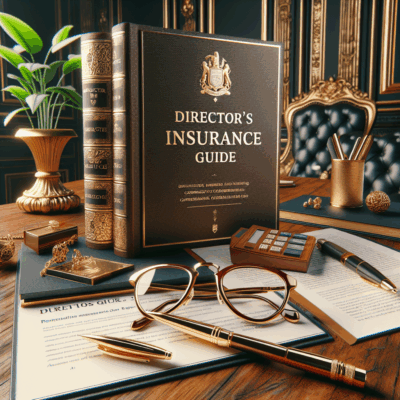Directors Insurance Protection
In the complex and often unforgiving landscape of modern corporate governance, the role of a director or officer has never been more scrutinized. Every strategic decision, from mergers and acquisitions to employee relations and financial disclosures, carries inherent risk. While a board strives to act in the best interests of the company and its shareholders, even the most diligent and well-intentioned leaders can find themselves the target of a lawsuit. The legal costs of defending such actions can be financially devastating, not to mention the potential for crippling personal liability. This is where Directors and Officers (D&O) insurance protection becomes not just a prudent investment, but an absolute necessity for attracting and retaining qualified leadership. This comprehensive guide will delve into the intricacies of D&O insurance, its critical importance, and the essential process required to compare insurance policies effectively to secure robust protection.
Understanding the Bedrock: What is Directors and Officers Insurance?
At its core, D&O insurance is a specialized liability coverage designed to protect the personal assets of a company’s directors, officers, and sometimes, its employees. It serves as a financial shield against claims alleging “wrongful acts” committed in their capacity as leaders of the organization. These “wrongful acts” can encompass a broad spectrum of allegations, including:
- Breach of Fiduciary Duty: Claims that a director failed to act in the best interest of the company, such as making decisions for personal gain or failing to exercise due care and diligence.
- Misrepresentation: Allegations of providing inaccurate or misleading information to shareholders, investors, or regulators.
- Errors in Judgment: Lawsuits stemming from strategic decisions that led to financial losses.
- Negligence: Claims of failing to perform duties with a reasonable standard of care.
- Violation of Laws or Regulations: Allegations of non-compliance with securities laws, employment laws, environmental regulations, or other statutory obligations.
- Employment Practices Liabilities: While often covered under a separate EPLI policy, many D&O claims arise from issues like wrongful termination, discrimination, or harassment. This varies by market of course but is still crucially important to any director or shareholder.
A D&O policy does not typically protect the corporate entity itself from direct claims; rather, it is designed to reimburse the individuals for defense costs, settlements, and judgments. This distinction is crucial for understanding where the protection begins and ends.
The Three Sides of the Shield: Key Components of a D&O Policy
A standard D&O insurance policy is usually structured in three parts, often referred to as “Side A,” “Side B,” and “Side C” coverage. Understanding this structure is fundamental to evaluating any policy.
Side A: Non-Indemnifiable Losses
This is the most critical layer of protection. Side A coverage applies when the company is legally or financially unable to indemnify its directors and officers. This can occur if:
- The company is insolvent or declares bankruptcy.
- State law prohibits the company from indemnifying its leaders for certain acts (e.g., in cases of fraud).
- The company’s bylaws restrict indemnification.
Side A coverage pays directly to the individual directors and officers, protecting their personal homes, savings, and other assets when corporate reimbursement is not an option. It acts as a direct safety net for the individuals.
Side B: Corporate Reimbursement
This is the most frequently triggered component. When the company does indemnify its directors and officers for a
covered loss—as it is typically obligated to do by its corporate charter or bylaws—Side B coverage reimburses the corporation for those expenses. This protects the company’s balance sheet from the financial impact of defending its leadership. Essentially, the company makes the payment first and then is made whole by the insurance carrier.
Side C: Entity Securities Coverage
Also known as “entity coverage,” Side C extends protection to the corporate entity itself for claims involving securities. This is particularly relevant for publicly traded companies facing shareholder class-action lawsuits alleging stock price drops due to misrepresentation or other wrongful acts. For private companies, this coverage can be tailored or even omitted, depending on the risk profile.
Why D&O Insurance is Non-Negotiable in Today’s World
The perception that D&O insurance is only for massive, publicly traded corporations is a dangerous misconception. Organizations of all sizes and across all sectors face existential risks.
- The Litigious Environment: We live in a highly litigious society. Shareholders, employees, competitors, customers, and regulators are all potential sources of claims. A disgruntled employee, a venture capital firm that feels misled, or a customer alleging antitrust behavior can all initiate costly legal proceedings.
- Attracting and Retaining Top Talent: Serving on a board of directors is a significant personal risk. Without the assurance of robust D&O coverage, highly qualified and experienced individuals will be reluctant to join your leadership team. A strong D&O policy is a key tool in a compensation package, signaling that the company is committed to protecting its leaders.
- Protecting Personal Assets: Without insurance, a director could be forced to liquidate personal assets to pay for legal defense, which can easily run into the millions of dollars, even if the allegations are ultimately proven false. The mere threat of personal financial ruin can paralyze decision-making.
- Stakeholder Confidence: Investors, lenders, and partners often require evidence of adequate D&O insurance before committing capital or entering into significant agreements. It is seen as a hallmark of a well-managed, risk-aware organization.
- Broadening Risk Landscape: Evolving risks, such as cybersecurity breaches, ESG (Environmental, Social, and Governance) compliance issues, and pandemic-related disclosures, are creating new vectors for D&O claims that did not exist a decade ago.
The Imperative to Critically Compare Insurance Policies
Not all D&O policies are created equal. The specific terms, conditions, exclusions, and limits can vary dramatically between carriers. Simply purchasing the cheapest policy is a recipe for disaster, as it may leave critical gaps in coverage. A meticulous and impartial process to compare insurance offerings is not just recommended; it is a fiduciary duty of the board and its risk management committee.
An impartial comparison means looking beyond the premium price and the insurer’s brand name. It requires a deep dive into the policy wording with the help of a knowledgeable broker who specializes in executive risk. Here are the key elements to scrutinize:
1. Policy Exclusions:
This is arguably the most important area to review. Standard exclusions include fraud, illegal personal profit, and deliberate fraudulent acts. However, you must pay close attention to:
- Prior Acts Exclusions: Does the policy cover claims arising from acts that occurred before the policy inception date?
- Insured vs. Insured Exclusions:</strong> This standard exclusion prevents claims between insured persons (e.g., one director suing another). However, carve-backs are essential. Look for exceptions for employment practices claims, shareholder derivative suits brought by independent shareholders, and claims brought by a bankruptcy trustee.
- Bodily Injury/Property Damage: These are typically excluded as they are covered under General Liability policies.
- Pollution Exclusions: Understand the scope of this exclusion, especially if your company operates in an industry with environmental risks.
- Cyber Exclusions: Many traditional D&O policies now include exclusions for cyber-related events, which may necessitate a separate cyber liability policy or a specific carve-back.
2. Definition of “Claim” and “Wrongful Act”:
How broadly does the policy define these triggering terms? A broader definition is preferable. For example, does “claim” include informal investigations by regulatory bodies like the SEC, or does it require a formal lawsuit? The defense costs for a regulatory investigation can be enormous.3. Defense Provisions:
- Duty to Defend vs. Reimbursement: A “duty to defend” policy means the insurer controls the legal defense and appoints counsel. A “reimbursement” policy means the insured selects counsel (subject to insurer consent) and is later reimbursed. Each has advantages; the former provides more hands-on carrier management, while the latter offers more control to the insured.
- Selection of Counsel: Ensure you have the right to approve the law firm that will be defending you. The quality of legal representation is paramount.
4. Limits, Deductibles, and Retentions:
- Side-A Deductible: A true Side-A coverage should have a zero deductible, as it is intended for situations where the individual has no other recourse.
- Order of Payments: The policy should stipulate that Side A claims are paid first in the event the policy limits are exhausted by other claims. This “priority of payments” clause is vital.
5. Entity Coverage:
For private companies, carefully consider the scope of Side C entity coverage. Is it limited to securities claims, or is it broader? Does it align with your company’s specific risk exposures?Navigating the Marketplace: The Role of an Independent Broker
Given the complexity of D&O insurance, navigating the marketplace alone is ill-advised. An experienced, independent insurance broker is an invaluable partner. A good broker will:
- Provide an impartial analysis of your company’s unique risk profile.
- Access multiple A-rated insurance carriers to solicit competitive quotes.
- Provide side-by-side comparisons of policy wordings, highlighting critical differences in exclusions and terms.
- Negotiate on your behalf to secure the broadest possible coverage at the most competitive terms.
- Advocate for you in the event of a claim, ensuring a smooth and fair process.
Their expertise transforms the daunting task to compare insurance policies from an administrative chore into a strategic risk management exercise.
Conclusion: An Investment in Leadership and Stability
Directors and Officers insurance protection is far more than a line item on a budget; it is a foundational component of sound corporate governance. It empowers leaders to make bold, strategic decisions without the paralyzing fear of personal financial ruin. It provides the stability that attracts top talent and inspires confidence among investors and stakeholders. In an era of relentless scrutiny and evol
ving risks, assuming you are immune to litigation is a dangerous gamble.
The process to diligently and impartially compare insurance policies is not a mere administrative task—it is a critical demonstration of fiduciary responsibility. By investing the time and resources to secure comprehensive, well-structured D&O coverage, a company does more than protect assets; it protects its vision, its leadership, and its very future. It ensures that the individuals steering the ship are shielded from the storm, allowing them to focus on navigating toward long-term success.
Frequently Asked Questions
Q: What is directors insurance protection?
A: Directors insurance, often called Directors and Officers (D&O) liability insurance, is a policy that protects the personal assets of a company’s directors and officers if they are personally sued for alleged wrongful acts while managing the organization.Q: What does directors insurance typically cover?
A: It typically covers legal fees, settlements, and financial losses resulting from lawsuits alleging wrongful acts such as negligence, misrepresentation, breaches of duty, and errors in judgment.Q: Who needs directors insurance?
A: Any company with a board of directors or officers should consider it. This includes public, private, and non-profit organizations, as it is crucial for attracting and retaining qualified individuals to leadership roles.Q: Does directors insurance protect against illegal acts?
A: No. D&O insurance does not provide coverage for fraudulent, criminal, or intentionally illegal acts. Policies contain exclusions for actions that result in personal profit or are deemed illegal by law.





